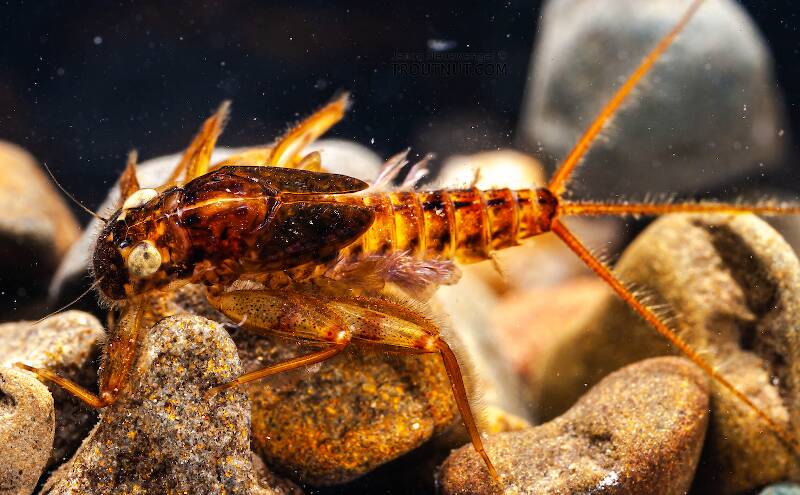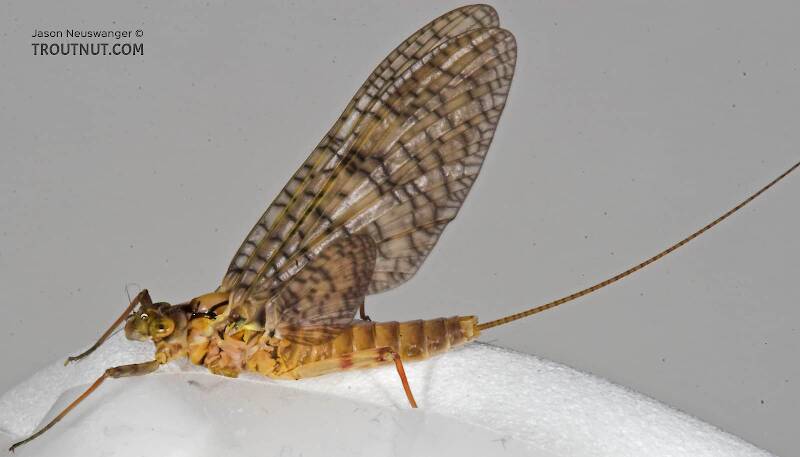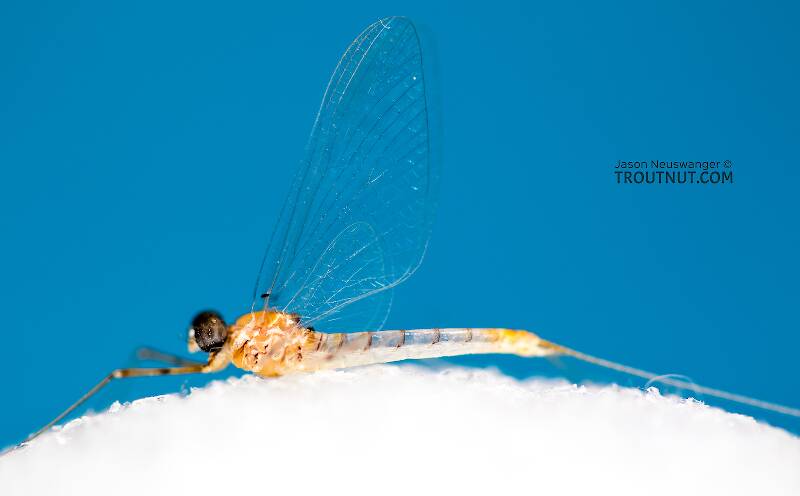
Salmonflies
Pteronarcys californica
The giant Salmonflies of the Western mountains are legendary for their proclivity to elicit consistent dry-fly action and ferocious strikes.
Featured on the forum

Troutnut is a project started in 2003 by salmonid ecologist Jason "Troutnut" Neuswanger to help anglers and
fly tyers unabashedly embrace the entomological side of the sport. Learn more about Troutnut or
support the project for an enhanced experience here.
March Browns, Cahills, Quill Gordons
This common name refers to only one family. Click its scientific name to learn more.
Mayfly Family Heptageniidae
These are pretty much always called March Browns, Cahills, Quill Gordons.
Known as the "clinger" mayflies to anglers, a few species of this family can be extremely prolific, with a lot more that aren't. These lesser species account for many of the curious mayflies you find that never seem to associate with a major hatch, let alone a fishable one. Not all heptageniid species are so scarce though; there are superhatches too.
Heptageniids can be broken into "groups" of similar genera (based on angling concerns) to help keep track of them. Although many of them are closely related, they are not officially divided in this way by entomologists. Here are the groups:
The genus Stenonema, who's Latin name was one of the first etched in the minds of anglers, was for a while largely reclassified into Maccaffertium but has since been reinstated. It includes the March Brown (S. vicarium) and Gray Fox (previously S. fuscum) superhatches.
The Stenonema species are for all practical purposes limited to the East and Midwest.
While Heptagenia has held on to several species, many of its fishable hatches have been moved to the genera Leucrocuta, Nixe, and Ecdyonurus. Some species of Nixe were subsequently moved to Afghanurus. There are many former Heptagenia species across the continent, but few are important to anglers. Of those, more are in the West than in the East.
The closely related genera Epeorus and Ironodes are among the only mayflies to have just two tails as nymphs. Good populations can be found in the West, but it's in the East where the mayfly named after the man that brought the dry fly to America can be found, the superhatch Epeorus pleuralis or Quill Gordon.
The genus Rhithrogena can be identified by the gills of its nymphs. They extend underneath the abdomen in the front and the back. They are very important for early season anglers in the West, but not very often in the East. For western anglers, it's duns are the blotchy winged equivalent of the East's March Brown (Maccaffertium vicarium). Ironically, it is only the Western March Brown that is in the same genus as the English species for which the common name originated.
The genus Cinygmula is easily distinguished by the nymph's enlarged palpi (mouth parts) that stick out from both sides of their heads like little blunt horns. They rarely produce fishable hatches, and none are of much significance except for a few species, mostly in certain locales of the West.
Heptageniids can be broken into "groups" of similar genera (based on angling concerns) to help keep track of them. Although many of them are closely related, they are not officially divided in this way by entomologists. Here are the groups:
Stenonema (blotchy wings)
The genus Stenonema, who's Latin name was one of the first etched in the minds of anglers, was for a while largely reclassified into Maccaffertium but has since been reinstated. It includes the March Brown (S. vicarium) and Gray Fox (previously S. fuscum) superhatches.
The Stenonema species are for all practical purposes limited to the East and Midwest.
Former Heptagenia (plain wings)
While Heptagenia has held on to several species, many of its fishable hatches have been moved to the genera Leucrocuta, Nixe, and Ecdyonurus. Some species of Nixe were subsequently moved to Afghanurus. There are many former Heptagenia species across the continent, but few are important to anglers. Of those, more are in the West than in the East.
Epeorus (two-tailed Nymphs, plain wings)
The closely related genera Epeorus and Ironodes are among the only mayflies to have just two tails as nymphs. Good populations can be found in the West, but it's in the East where the mayfly named after the man that brought the dry fly to America can be found, the superhatch Epeorus pleuralis or Quill Gordon.
Rhithrogena (suction cup gills)
The genus Rhithrogena can be identified by the gills of its nymphs. They extend underneath the abdomen in the front and the back. They are very important for early season anglers in the West, but not very often in the East. For western anglers, it's duns are the blotchy winged equivalent of the East's March Brown (Maccaffertium vicarium). Ironically, it is only the Western March Brown that is in the same genus as the English species for which the common name originated.
Cinygmula (horn heads)
The genus Cinygmula is easily distinguished by the nymph's enlarged palpi (mouth parts) that stick out from both sides of their heads like little blunt horns. They rarely produce fishable hatches, and none are of much significance except for a few species, mostly in certain locales of the West.

This specimen seems to be of the same species as a dun I photographed which emerged from another nymph in the same sample.
See 238 more specimens...




